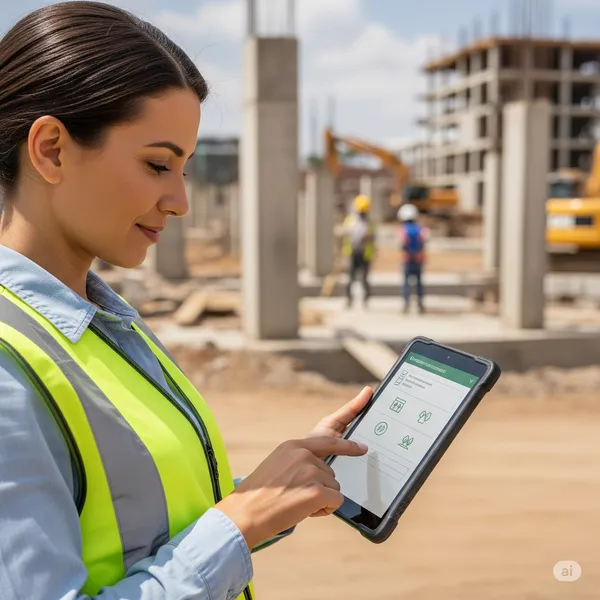Monitoring for Compliance with Environmental and Social Standards
Published on: Tue Jun 18 2024 by Ivar Strand
Monitoring for Compliance: Verifying Adherence to Environmental and Social Standards
Introduction
Environmental and Social Standards (ESS) are no longer a peripheral consideration in development finance; they are a core component of fiduciary duty and ethical practice. For major funders and their partners, adhering to established safeguards is a non-negotiable requirement designed to ensure that projects actively mitigate harm and generate sustainable, equitable outcomes.
However, verifying compliance with these standards presents a distinct challenge. Unlike monitoring the construction of a school, which involves tracking tangible outputs, ESS monitoring requires the assessment of processes, behaviours, and the effective mitigation of complex risks. This demands a specialized methodology that goes beyond simple checklists. This paper outlines a structured approach to compliance monitoring, distinguishing between key safeguard areas and addressing the unique challenges of sensitive protection issues.
1. Verifying Environmental Safeguards
This is often the most tangible aspect of ESS monitoring, focused on a project’s interaction with the physical environment. Verification is grounded in direct observation and the comparison of technical plans against on-the-ground reality. Key areas of inquiry include:
- Waste Management and Pollution Control: Verifying that systems for the disposal of solid waste and the management of effluents are in place and functioning as designed.
- Resource Management: Assessing whether commitments regarding water usage, land clearance, and the protection of natural habitats are being met.
- Erosion and Land Degradation: Directly observing whether required measures like terracing, retaining walls, or revegetation have been properly implemented at construction sites.
The methodology combines a rigorous review of the project’s Environmental and Social Management Plan (ESMP) with physical site inspections and, where necessary, cross-referencing with satellite imagery or technical data.
2. Verifying Social Safeguards
Monitoring social safeguards requires a shift toward more qualitative, engagement-based methods to assess a project’s impact on people and communities. The focus is on verifying that processes are fair, inclusive, and protect the vulnerable. This includes:
- Labour and Working Conditions: Verifying adherence to national laws and international standards. This is done through confidential interviews with workers, spot-checks of employment records, and direct observation of workplace safety conditions. The objective is to confirm fair wages, reasonable working hours, and the absence of child or forced labour.
- Community Health and Safety: Assessing whether project activities are creating new risks for local communities and whether mitigation measures (e.g., traffic management, site security) are effective.
- Meaningful Consultation: Verifying that stakeholder engagement is not just a box-ticking exercise. This involves reviewing records of community meetings and, crucially, speaking with community members—including women and marginalized groups—to ascertain if their voices were heard and their concerns considered.
3. The Specialized Task of Monitoring Protection Safeguards
Perhaps the most critical and sensitive area of ESS is the protection of individuals from harm, particularly from Gender-Based Violence (GBV) and Sexual Exploitation and Abuse (SEA). Monitoring in this domain is governed by the absolute, overriding principle of “Do No Harm.”
It is essential to clarify the monitor’s role. A monitor is not an investigator and does not actively search for individual cases or survivors. Doing so without specialized training and support systems would be irresponsible and dangerous.
Instead, the monitor’s role is to verify that the systems to prevent and respond to GBV/SEA are in place, known, and functional. Key verification questions include:
- Are there safe, confidential, and accessible channels for reporting incidents?
- Are project staff and community members aware of these reporting channels and how to use them?
- Is there a clear, survivor-centric protocol to refer any reported cases to independent, specialized service providers (e.g., health, psychosocial, legal aid)?
- Have all project staff signed and been trained on a code of conduct that explicitly prohibits GBV and SEA?
The methodology here is discreet, relying on careful document review and confidential interviews with project management and designated protection focal points.
4. The Grievance Redress Mechanism (GRM) as a Key Indicator
A project’s Grievance Redress Mechanism (GRM) is a formal channel for any stakeholder to raise complaints and seek resolution. The functionality of the GRM serves as a powerful proxy indicator for the overall health of a project’s commitment to social accountability.
Monitoring the GRM involves assessing three factors:
- Accessibility: Is it well-publicized in local languages? Are there multiple channels for submission (e.g., phone, in-person)? Is it safe to use without fear of reprisal?
- Functionality: Are complaints being systematically logged, acknowledged, and addressed within a reasonable timeframe?
- Perceived Fairness: Do stakeholders who have used the system believe the process was transparent and fair, regardless of the outcome?
Verification requires reviewing the GRM’s records and conducting confidential interviews with community members, including those who have used the mechanism.
Conclusion
Monitoring for compliance with Environmental and Social Standards is not a monolithic task. It demands a differentiated methodology that is sensitive to the nature of each standard. It requires technical acumen for environmental verification, nuanced qualitative skills for social engagement, and a highly specialized, systems-focused, and ethically-grounded approach for protection safeguards. Ultimately, ESS compliance monitoring is the mechanism that ensures development projects not only achieve their intended good but also uphold their fundamental responsibility to do no harm.



